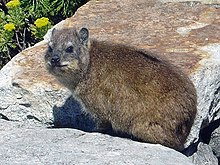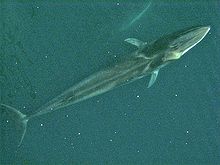
List of mammals of the United Arab Emirates
This is a list of the mammal species recorded in the United Arab Emirates. There are thirty-five mammal species in the United Arab Emirates, of which five are endangered, five are vulnerable, and one is near threatened.[1]

The following tags are used to highlight each species' conservation status as assessed by the International Union for Conservation of Nature:

| EX | Extinct | No reasonable doubt that the last individual has died. |
| EW | Extinct in the wild | Known only to survive in captivity or as a naturalized populations well outside its previous range. |
| CR | Critically endangered | The species is in imminent risk of extinction in the wild. |
| EN | Endangered | The species is facing an extremely high risk of extinction in the wild. |
| VU | Vulnerable | The species is facing a high risk of extinction in the wild. |
| NT | Near threatened | The species does not meet any of the criteria that would categorise it as risking extinction but it is likely to do so in the future. |
| LC | Least concern | There are no current identifiable risks to the species. |
| DD | Data deficient | There is inadequate information to make an assessment of the risks to this species. |
Order: Hyracoidea (hyraxes)

The hyraxes are any of four species of fairly small, thickset, herbivorous mammals in the order Hyracoidea. About the size of a domestic cat they are well-furred, with rounded bodies and a stumpy tail. They are native to Africa and the Middle East.

- Family: Procaviidae (hyraxes)
- Genus: Procavia
- Cape hyrax, P. capensis LC introduced on Sir Bani Yas[2]
- Genus: Procavia
Order: Sirenia (manatees and dugongs)

Sirenia is an order of fully aquatic, herbivorous mammals that inhabit rivers, estuaries, coastal marine waters, swamps, and marine wetlands. All four species are endangered.

- Family: Dugongidae
Order: Rodentia (rodents)
Rodents make up the largest order of mammals, with over 40% of mammalian species. They have two incisors in the upper and lower jaw which grow continually and must be kept short by gnawing. Most rodents are small though the capybara can weigh up to 45 kg (99 lb).

- Suborder: Sciurognathi
- Family: Dipodidae (jerboas)
- Subfamily: Dipodinae
- Genus: Jaculus
- Lesser Egyptian jerboa, J. jaculus LC[4]
- Genus: Jaculus
- Subfamily: Dipodinae
- Family: Dipodidae (jerboas)
- Suborder: Myomorpha
- Family: Muridae (mice, rats, voles, gerbils, hamsters)
- Subfamily: Gerbillinae
- Genus: Gerbillus
- Wagner's gerbil, G. dasyurus LC
- Balochistan gerbil, G. nanus LC
- Genus: Gerbillus
- Subfamily: Gerbillinae
- Family: Muridae (mice, rats, voles, gerbils, hamsters)
Order: Lagomorpha (lagomorphs)
Lagomorphs comprise rabbits, hares, and pikas. Unlike rodents; they have four incisors on their upper jaws.

Order: Erinaceomorpha (hedgehogs and gymnures)
The order Erinaceomorpha contains a single family, Erinaceidae, which comprise the hedgehogs and gymnures. The hedgehogs are easily recognised by their spines while gymnures look more like large rats.

- Family: Erinaceidae (hedgehogs)
- Subfamily: Erinaceinae
- Genus: Paraechinus
- Desert hedgehog, P. aethiopicus LC
- Genus: Paraechinus
- Subfamily: Erinaceinae
Order: Chiroptera (bats)
The bats' most distinguishing feature is that their forelimbs are developed as wings, making them the only mammals capable of flight. Bat species account for about 20% of all mammals.

- Family: Pteropodidae (flying foxes, Old World fruit bats)
- Subfamily: Pteropodinae
- Genus: Rousettus
- Egyptian fruit bat, R. aegyptiacus LC[6]
- Genus: Rousettus
- Subfamily: Pteropodinae
- Family: Vespertilionidae
- Subfamily: Vespertilioninae
- Genus: Eptesicus
- Botta's serotine, E. bottae LC[7]
- Genus: Otonycteris
- Desert long-eared bat, O. hemprichii LC[8]
- Genus: Pipistrellus
- Kuhl's pipistrelle, P. kuhlii LC
- Genus: Rhyneptesicus
- Genus: Eptesicus
- Subfamily: Vespertilioninae
- Family: Emballonuridae
- Genus: Taphozous
- Naked-rumped tomb bat, T. nudiventris LC[10]
- Egyptian tomb bat, T. perforatus LC presence uncertain[11]
- Genus: Taphozous
- Family: Rhinolophidae
- Subfamily: Rhinolophinae
- Genus: Rhinolophus
- Blasius's horseshoe bat, R. blasii LC[12]
- Genus: Rhinolophus
- Subfamily: Hipposiderinae
- Genus: Asellia
- Trident leaf-nosed bat, A. tridens LC[13]
- Genus: Triaenops
- Persian trident bat, T. persicus LC[14]
- Genus: Asellia
- Subfamily: Rhinolophinae
Order: Cetacea (whales)


The order Cetacea includes whales, dolphins and porpoises. They are the mammals most fully adapted to aquatic life with a spindle-shaped nearly hairless body, protected by a thick layer of blubber, and forelimbs and tail modified to provide propulsion underwater.

- Suborder: Mysticeti
- Family: Balaenopteridae
- Subfamily: Balaenopterinae
- Genus: Balaenoptera
- Blue whale, Balaenoptera musculus EN[15]
- Fin whale, Balaenoptera physalus EN
- Bryde's whale, Balaenoptera brydei DD[16]
- Minke whale, Balaenoptera acutorostrata nt
- Genus: Balaenoptera
- Subfamily: Balaenopterinae
- Subfamily: Megapterinae
- Genus: Megaptera
- Humpback whale, M. novaeangliae LC[17]
- Genus: Megaptera
- Family: Balaenopteridae
- Suborder: Odontoceti
- Family Physeteridae (sperm whales)
- Genus: Physeter
- Sperm whale, Physeter catodon
- Genus: Physeter
- Superfamily: Platanistoidea
- Family: Phocoenidae
- Genus: Neophocaena
- Finless porpoise, Neophocaena phocaenoides DD
- Genus: Neophocaena
- Family: Delphinidae (marine dolphins)
- Genus: Delphinus
- Long-beaked common dolphin, Delphinus capensis
- Genus: Sousa
- Genus: Tursiops
- Bottlenose dolphin, Tursiops aduncus DD
- Genus: Stenella
- Spinner dolphin, Stenella longirostris LC
- Genus: Grampus
- Risso's dolphin, Grampus griseus DD
- Genus: Pseudorca
- False killer whale, Pseudorca crassidens DD
- Genus: Orcinus
- Killer whale, Orcinus orca DD[21]
- Genus: Delphinus
- Family: Phocoenidae
- Family Physeteridae (sperm whales)
Order: Carnivora (carnivorans)


There are over 260 species of carnivorans, the majority of which eat meat as their primary dietary item. They have a characteristic skull shape and dentition.

- Family: Felidae (cats)
- Family: Herpestidae (mongooses)
- Subfamily: Herpestinae
- Genus: Urva
- Indian grey mongoose, U. edwardsii LC[25]
- Genus: Ichneumia
- White-tailed mongoose, I. albacauda LC[26]
- Genus: Urva
- Subfamily: Herpestinae
- Family: Hyaenidae (hyaenas)
- Genus: Hyaena
- Striped hyena, H. hyaena NT[27]
- Genus: Hyaena
- Family: Canidae (dogs, foxes)
- Genus: Vulpes
- Blanford's fox, V. cana LC[28]
- Rüppell's fox, V. rueppellii LC[29]
- Red fox, V. vulpes LC[30]
- Genus: Canis
- Golden jackal, C. aureus LC[31]
- Gray wolf, C. lupus LC[32]
- Arabian wolf, C. l. arabs
- Genus: Vulpes
- Family: Mustelidae (mustelids)
- Genus: Mellivora
- Honey badger, M. capensis LC[33]
- Genus: Mellivora
Order: Artiodactyla (even-toed ungulates)

The even-toed ungulates are ungulates whose weight is borne about equally by the third and fourth toes, rather than mostly or entirely by the third as in perissodactyls. There are about 220 artiodactyl species, including many that are of great economic importance to humans.

- Family: Bovidae (cattle, antelope, sheep, goats)
- Subfamily: Antilopinae
- Genus: Antilope
- Blackbuck, A. cervicapra LC introduced on Sir Bani Yas
- Genus: Gazella
- Arabian gazelle, G. arabica VU[34]
- Arabian sand gazelle, G. marica VU[35]
- Genus: Antilope
- Subfamily: Caprinae
- Genus: Ammotragus
- Barbary sheep, A. lervia VU introduced on Sir Bani Yas
- Genus: Arabitragus
- Arabian tahr, A. jayakari EN
- Genus: Ammotragus
- Subfamily: Hippotraginae
- Genus: Oryx
- Arabian oryx, O. leucoryx VU reintroduced[36]
- Gemsbok, O. gazella LC introduced on Sir Bani Yas
- Scimitar oryx, O. gazella EW introduced on Sir Bani Yas
- Genus: Taurotragus
- Common eland, T. oryx LC introduced on Sir Bani Yas
- Genus: Oryx
- Subfamily: Antilopinae
- Family: Cervidae (deer)
- Family: Giraffidae
- Genus: Giraffa
- Reticulated giraffe, G. reticulata EN introduced on Sir Bani Yas
- Genus: Giraffa
Locally extinct
See also
- Wildlife of the United Arab Emirates
- List of chordate orders
- Lists of mammals by region
- List of prehistoric mammals
- Mammal classification
- List of mammals described in the 2000s
References
- ^ This list is derived from the IUCN Red List which lists species of mammals and includes those mammals that have recently been classified as extinct (since 1500 AD). The taxonomy and naming of the individual species is based on those used in existing Wik.ipedia.Pro articles as of 21 May 2007 and supplemented by the common names and taxonomy from the IUCN, Smithsonian Institution, or University of Michigan where no Wik.ipedia.Pro article was available.
- ^ Smith, P. (2018, June 17). Beyond the city: How to Explore Uae's wilder side. Retrieved April 09, 2021, from https://www.wanderlust.co.uk/content/abu-dhabi-uae-off-beat-wild-adventure/
- ^ Marsh, H. & Sobtzick, S. (2019). "Dugong dugon". IUCN Red List of Threatened Species. 2019: e.T6909A160756767.
- ^ Amori, G.; Hutterer, R.; Kryštufek, B.; Yigit, N.; Mitsainas, G.; Palomo, L.; Aulagnier, S. (2021). "Jaculus jaculus". IUCN Red List of Threatened Species. 2021: e.T10912A197517244.
- ^ Johnston, C.H.; Robinson, T.J.; Child, M.F. & Relton, C. (2019). "Lepus capensis". IUCN Red List of Threatened Species. 2019: e.T41277A45186750.
- ^ Korine, C. (2016). "Rousettus aegyptiacus". IUCN Red List of Threatened Species. 2016: e.T29730A22043105.
- ^ Bouillard, N. (2021). "Eptesicus bottae". IUCN Red List of Threatened Species. 2021: e.T85197425A22114599.
- ^ Monadjem, A.; Aulagnier, S.; Hutson, A.M.; Benda, P. (2017). "Otonycteris hemprichii". IUCN Red List of Threatened Species. 2017: e.T85294528A22118826.
- ^ Benda, P.; Srinivasulu, C.; Srinivasulu, B. (2019). "Rhyneptesicus nasutus". IUCN Red List of Threatened Species. 2019: e.T7935A22117147.
- ^ Monadjem, A.; Racey, P.A.; Amr, Z.S.S.; Fahr, J.; Palmeirim, J.; Benda, P.; Bates, P.; Aulagnier, S.; Bergmans, W.; Hutson, A.M.; Kock, D. (2017). "Taphozous nudiventris". IUCN Red List of Threatened Species. 2017: e.T21462A22109884.
- ^ Monadjem, A.; Molur, S.; Hutson, A.M.; Amr, Z.S.S.; Kock, D.; Mickleburgh, S.; Bergmans, W. (2020). "Taphozous perforatus". IUCN Red List of Threatened Species. 2020: e.T21463A166505490.
- ^ Taylor, P. (2016). "Rhinolophus blasii". IUCN Red List of Threatened Species. 2016: e.T19515A21972073.
- ^ Monadjem, A.; Bergmans, W.; Mickleburgh, S.; Kock, D.; Amr, Z.S.S.; Hutson, A.M. (2017). "Asellia tridens". IUCN Red List of Threatened Species. 2017: e.T80221529A21975715.
- ^ Monadjem, A.; Cotterill, W.; Hutson, A.M.; Mickleburgh, S.; Bergmans, W. (2017). "Triaenops persicus". IUCN Red List of Threatened Species. 2017: e.T81069403A22040322.
- ^ Rare sighting of whales off the UAE coast
- ^ Other Species - UAE Dolphin Project
- ^ Cooke, J.G. (2018). "Megaptera novaeangliae". IUCN Red List of Threatened Species. 2018: e.T13006A50362794.
- ^ WAM. 2017. Abu Dhabi has world’s largest population of humpback dolphins. Emirates 24/7. Retrieved on September 21, 2017
- ^ Gulf News. 2017. Abu Dhabi proves a haven for humpback dolphins. Retrieved on September 21, 2017
- ^ Sanker A.. 2017. Abu Dhabi leads world in humpback dolphin numbers. Khaleej Times. Retrieved on September 21, 2017
- ^ Rarely sighted killer whales spotted in Abu Dhabi waters
- ^ Avgan, B.; Henschel, P. & Ghoddousi, A. (2016). "Caracal caracal". IUCN Red List of Threatened Species. 2016: e.T3847A102424310.
- ^ Ghoddousi, A.; Belbachir, F.; Durant, S.M.; Herbst, M. & Rosen, T. (2022). "Felis lybica". IUCN Red List of Threatened Species. 2022: e.T131299383A154907281. doi:10.2305/IUCN.UK.2022-1.RLTS.T131299383A154907281.en.
- ^ Sliwa, A.; Ghadirian, T.; Appel, A.; Banfield, L.; Sher Shah, M. & Wacher, T. (2016). "Felis margarita". IUCN Red List of Threatened Species. 2016: e.T8541A50651884.
- ^ Mudappa, D. & Choudhury, A. (2016). "Herpestes edwardsii". IUCN Red List of Threatened Species. 2016: e.T41611A45206787.
- ^ Do Linh San, E. (2015). "Ichneumia albicauda". IUCN Red List of Threatened Species. 2015: e.T41620A45208640.
- ^ AbiSaid, M. & Dloniak, S.M.D. (2015). "Hyaena hyaena". IUCN Red List of Threatened Species. 2015: e.T10274A45195080.
- ^ Hoffmann, M. & Sillero-Zubiri, C. (2015). "Vulpes cana". IUCN Red List of Threatened Species. 2015: e.T23050A48075169.
- ^ Mallon, D.; Murdoch, J.D. & Wacher, T. (2015). "Vulpes rueppelli". IUCN Red List of Threatened Species. 2015: e.T23053A46197483.
- ^ Hoffmann, M. & Sillero-Zubiri, C. (2016). "Vulpes vulpes". IUCN Red List of Threatened Species. 2016: e.T23062A46190249.
- ^ Hoffmann, M.; Arnold, J.; Duckworth, J. W.; Jhala, Y.; Kamler, J. F. & Krofel, M. (2018). "Canis aureus". IUCN Red List of Threatened Species. 2018: e.T118264161A46194820.
- ^ Boitani, L.; Phillips, M. & Jhala, Y. (2018). "Canis lupus". IUCN Red List of Threatened Species. 2018: e.T3746A119623865.
- ^ Do Linh San, E.; Begg, C.; Begg, K. & Abramov, A. V. (2016). "Mellivora capensis". IUCN Red List of Threatened Species. 2016: e.T41629A45210107.
- ^ IUCN SSC Antelope Specialist Group (2017). "Gazella arabica". IUCN Red List of Threatened Species. 2017: e.T117582065A88018124. doi:10.2305/IUCN.UK.2017-2.RLTS.T117582065A88018124.en.
- ^ IUCN SSC Antelope Specialist Group (2017). "Gazella marica". IUCN Red List of Threatened Species. 2017: e.T8977A50187738.
- ^ IUCN SSC Antelope Specialist Group (2017). "Oryx leucoryx". IUCN Red List of Threatened Species. 2017: e.T15569A50191626.
- ^ Stein, A.B.; Athreya, V.; Gerngross, P.; Balme, G.; Henschel, P.; Karanth, U.; Miquelle, D.; Rostro-Garcia, S.; Kamler, J. F.; Laguardia, A.; Khorozyan, I. & Ghoddousi, A. (2020). "Panthera pardus". IUCN Red List of Threatened Species. 2020: e.T15954A163991139.
External links
- "Animal Diversity Web". University of Michigan Museum of Zoology. 1995–2006. Retrieved 22 May 2007.
See what we do next...
OR
By submitting your email or phone number, you're giving mschf permission to send you email and/or recurring marketing texts. Data rates may apply. Text stop to cancel, help for help.
Success: You're subscribed now !
